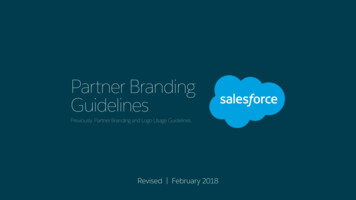
Transcription
MICROSOFTDYNAMICS 365OR SALESFORCE?
A look at key factors to consider when selectinga CRM for your life sciences company.When looking at Gartner’s latest Magic Quadrant for Sales Force Automation (SFA), you cansee a race to the top by two giants in their own rights. Salesforce currently holds the leadwith 19.8% of the market share, making it the gigantic leader in this space.1,2 While MicrosoftDynamics follows closely in second place with 7.2% of the market share, the enormity ofRedmond’s technology strength and innovation into areas like artificial intelligence (AI) needto be taken seriously despite the percentage difference mentioned above.3 To meet themodern customer-centric and sales goals, chosen CRM systems need to have a greaterprecision, predictive analytics, and a focus on customer needs and behavior.To help life science companies, we have prepared an evaluation of Microsoft Dynamics 365and Salesforce, their pros and cons along with elements to consider when making yourCRM choice.Where Is CRM Data Hosted?Salesforce’s genesis is a cloud application that works withvarious infrastructure technology vendors and partnerswithin the new public cloud-based data model.Microsoft CRM hasa broad set ofinternational andindustry-specificstandard compliancerequirements thatthe life scienceindustry must follow.Microsoft Dynamics 365 has different cloud andon-premises deployments available that include private,public, and hybrid features, which can be deployed basedon your budget. Microsoft’s globally distributed data centerinfrastructure supports thousands of online services andspans 100 highly secure facilities worldwide.4Microsoft Dynamics also benefits from being a part of alarge investment in the Healthcare vertical via Microsoft’sCloud for Healthcare program that provides “capabilities tomanage health data at scale and make it easier forhealthcare organizations to improve patients experience,coordinate care, and drive operational efficiency whilehelping support security, compliance, and interoperability ofhealth data.”5PAGE 02
PlatformsDynamics offers 11 core modules or “apps,”, five of which are CRM-centric such as sales,customer service, field service, project service automation, and marketing. The other sixmodules are enterprise resource planning (ERP), talent human resources (HR), finance andoperation, retail, mixed reality, business central for small and medium businesses (SMB), andAI (for sales, customer service, and market insight). The overall number of offerings makeDynamics a robust and complete business package.Salesforce’s CRM provides individual modules or clouds with the option to choose any andimplement. These modules include basic CRM functionalities of sales, such as datamanagement and marketing. Smaller specialized modules help introduce capabilities suchas marketing automation and field services.Overall, Microsoft offers single platform-built case management, basic marketing, andcustomer service as well as SFA. Whereas Salesforce offers only SFA thus additionaladd-ons need to be purchased separately.Pricing ModelsMicrosoft Dynamics 365 uses a flexiblepricing model to activate anyincremental expansion of users or datastorage. On-premises licensing isdifferent because of the variable factorssuch as server costs, software, and userlicensing. Additional cloud storage canalso be purchased if needed. Costs maynot seem like a significant considerationat first, but they can add up.Salesforce offers essentials,professional, and enterprise groupingsof plans and is, for the most part, moreexpensive than Dynamics.Due to the complex licensing models,life sciences companies will benefitfrom having a knowledgeable partnerto guide them.PAGE 03
Dynamics Offer More IntegrationAnother critical factor of Microsoft ecosystem is that virtually allthe other products are compatible with Dynamics. Life sciencescompany users could benefit due to existing familiarity withother Microsoft business apps and server’s technology such asSQL, SharePoint, Power BI, Outlook, Azure, Office and MS Teamsto innovate and streamline existing processes.6Salesforce’s native app integration had limited scope and easeof usage when compared to Microsoft’s suite of business appsand server solutions. However, Salesforce’s AppExchangeecosystem does boast 5,000 ready-to-install solutions.7Artificial Intelligence is LeadingNew CRM CapabilitiesMicrosoft’s’ continued investment in automation features and AIhas paid off — Gartner announced it as the 2021 leader for CloudAI Developer Services in its Magic Quadrant.8 Microsoft alreadyhas a Healthcare Bot service that has been used by life sciencesand healthcare organizations for multiple use cases such asAI-powered virtual healthcare triage assistants, field teamassistants, and medical chatbots.Life sciences companies can empower Microsoft’s AIinvestments into streamlining work, using contextual insightsgained from customer and sales interactions to identify andpredict better leads and opportunities, efficient relationshipsactioning, and deep customers retention.Salesforce’s does offer AI-driven Einstein Cloud that makesdeeper views in customers and sales opportunities.Both CRMs are committed in making better use of customerdata via AI technologies but given Microsoft’s AI investment, itsintegrated easy-to-use analytic tools such as Power BI andoverall technological superiority, the long-run advantage remainswith the Redmond giant in AI.PAGE 04
Social Media CampaignsModern CRMs need to be able to integrate and work with social media platforms. WithDynamics 365, marketing departments can create rich and engaging content that can bescheduled to post to social media sites as well as to gather valuable analytics. Dynamicsuse the Microsoft Social Engagement, a social media management and social listening app,as well as the Microsoft Relationship Sales app that integrates with LinkedIn data. Thismeans that Dynamics customers can tap into sales opportunities across users worldwide.This is significant for life sciences companies since 2 million doctors and nurses are onLinkedIn in North America alone.9ConclusionBoth Salesforce and Dynamics 365 are leaders in the CRM space, and both offer diversefeature sets, add-ons, and AI technology. Right now, Salesforce may be the market leader,but Dynamics 365 is gaining market share, investing in next generation technologies like AIand garnering analysts’ acclaim. Life sciences companies need to closely review theircurrent IT roadmaps to align to their strategic goals. As mentioned previously, partnerinteraction is key to make the best decision.References:1. Gartner Magic Quadrant for Sales Force Automation -quadrant-for-sales-force-automation2. Salesforce is #1 in Global CRM Market Share. -is-1-in-global-crm-market-share/3. Microsoft Dynamics. rosoft-dynamics-market-share4. Azure Facilities, Premises, and Physical Security. ndamentals/physical-security5. Microsoft Cloud for Healthcare. crosoft-cloud-for-healthcare6. Salesforce vs. Dynamics 365: A Pricing Comparison. ce-vs-dynamics-365-pricing-comparison/\7. Extend the Power of the Customer 360 With the Leading Enterprise Cloud ppexchange/faq/#: :text 0solve%20any%20business%20challenge8. Microsoft Named a Leader in 2021 Gartner Magic Quadrant for Cloud AI Developer gic-quadrant-for/ba-p/22231009. Over 2 Million North American Doctors and Nurses are on exeevo
Overall, Microsoft offers single platform-built case management, basic marketing, and customer service as well as SFA. Whereas Salesforce offers only SFA thus additional add-ons need to be purchased separately. Pricing Models Microsoft Dynamics 365 uses a flexible pricing model to activate any incremental expansion of users or data storage.











